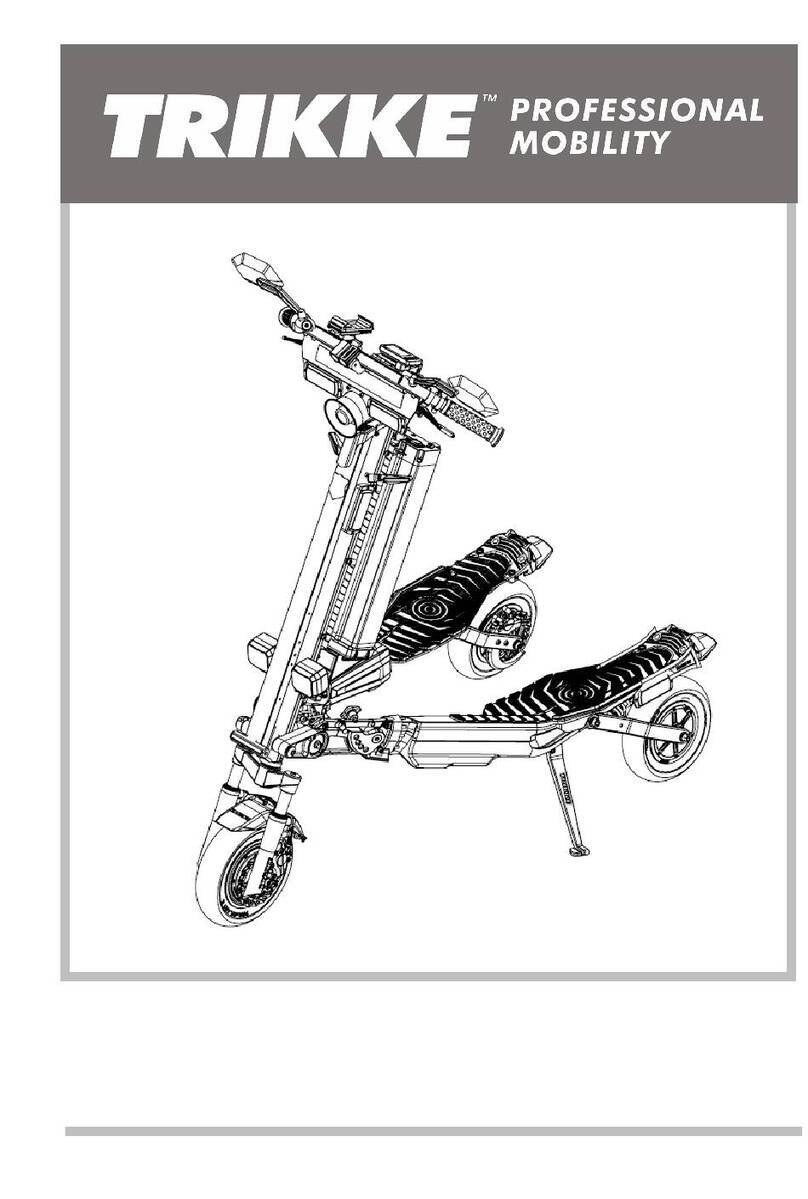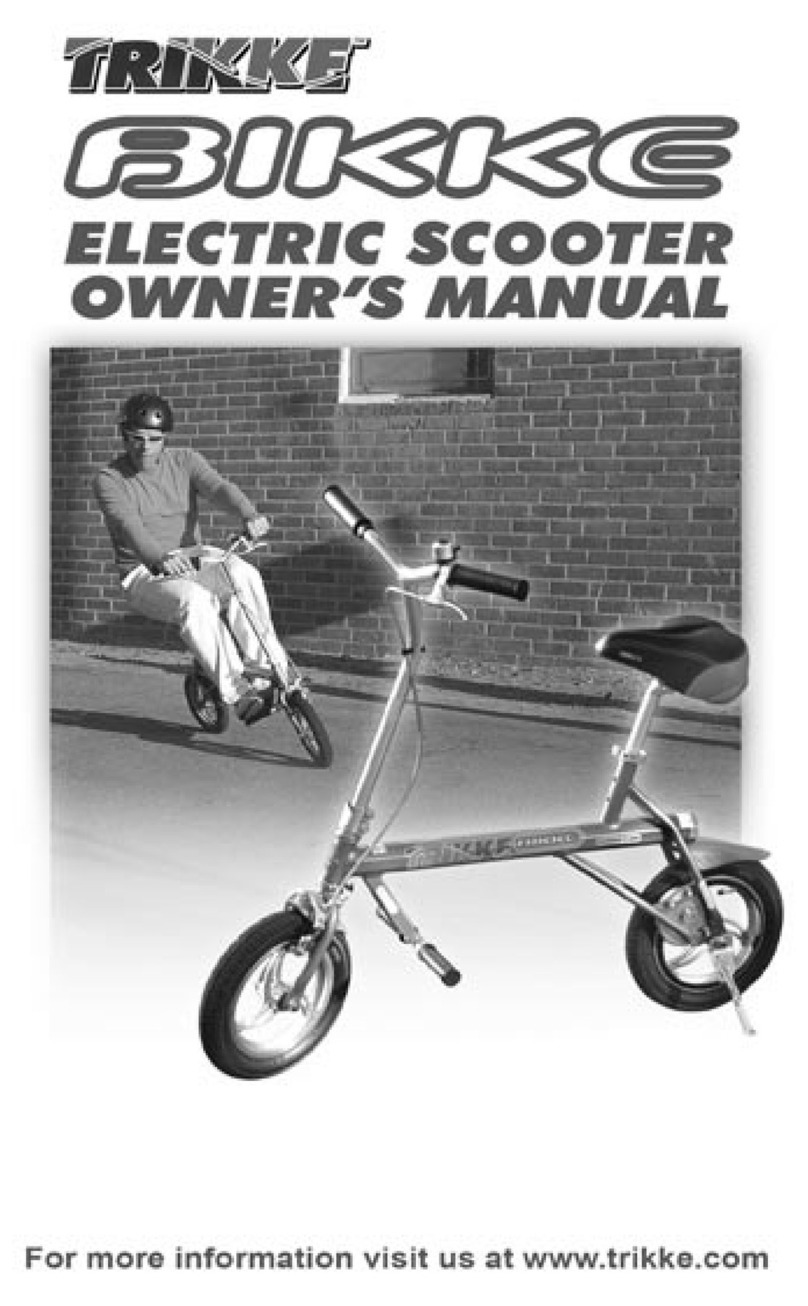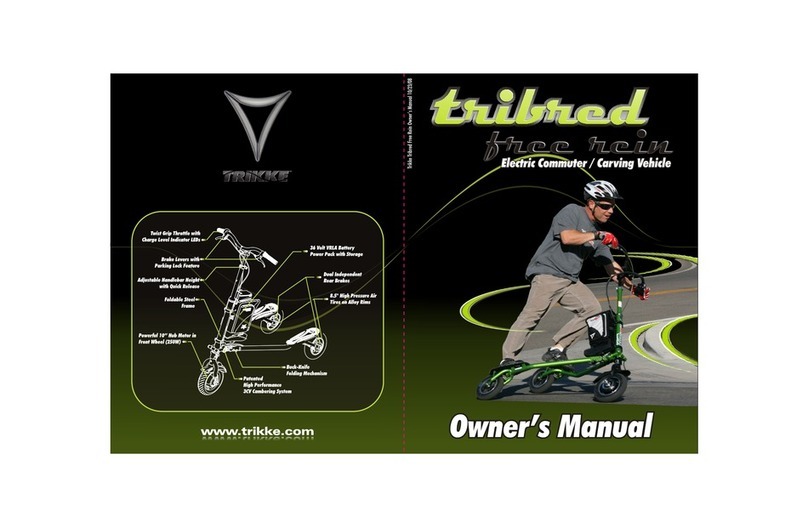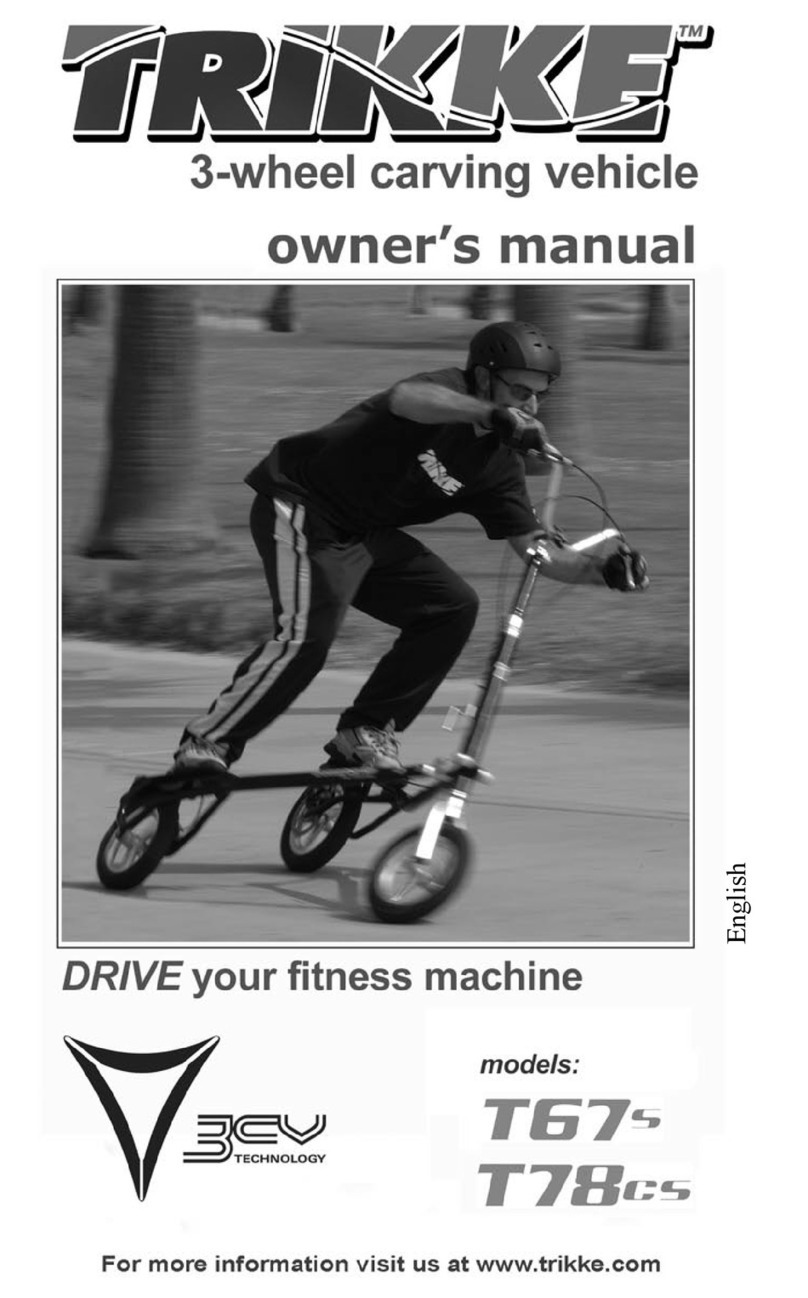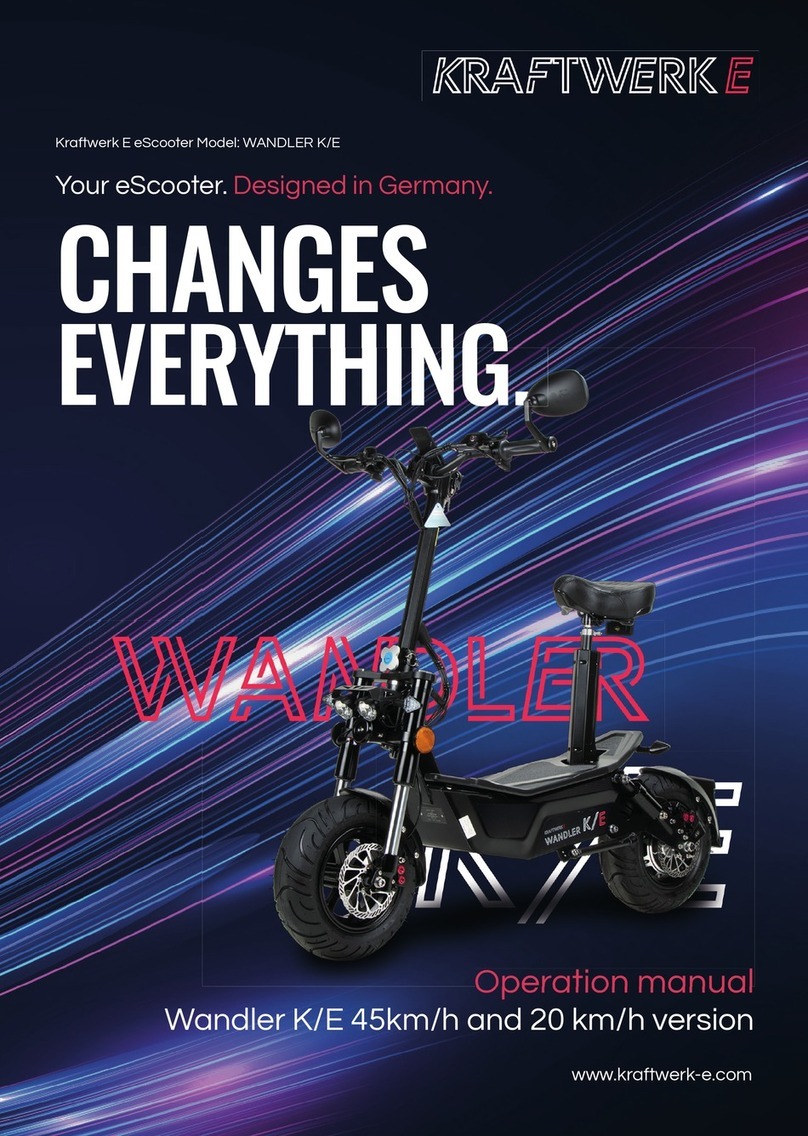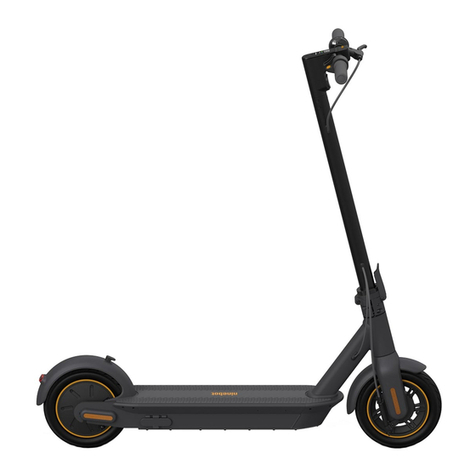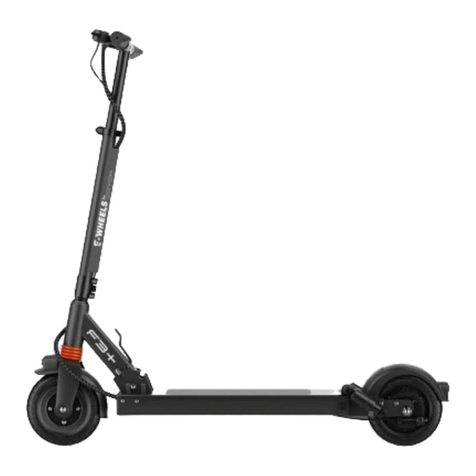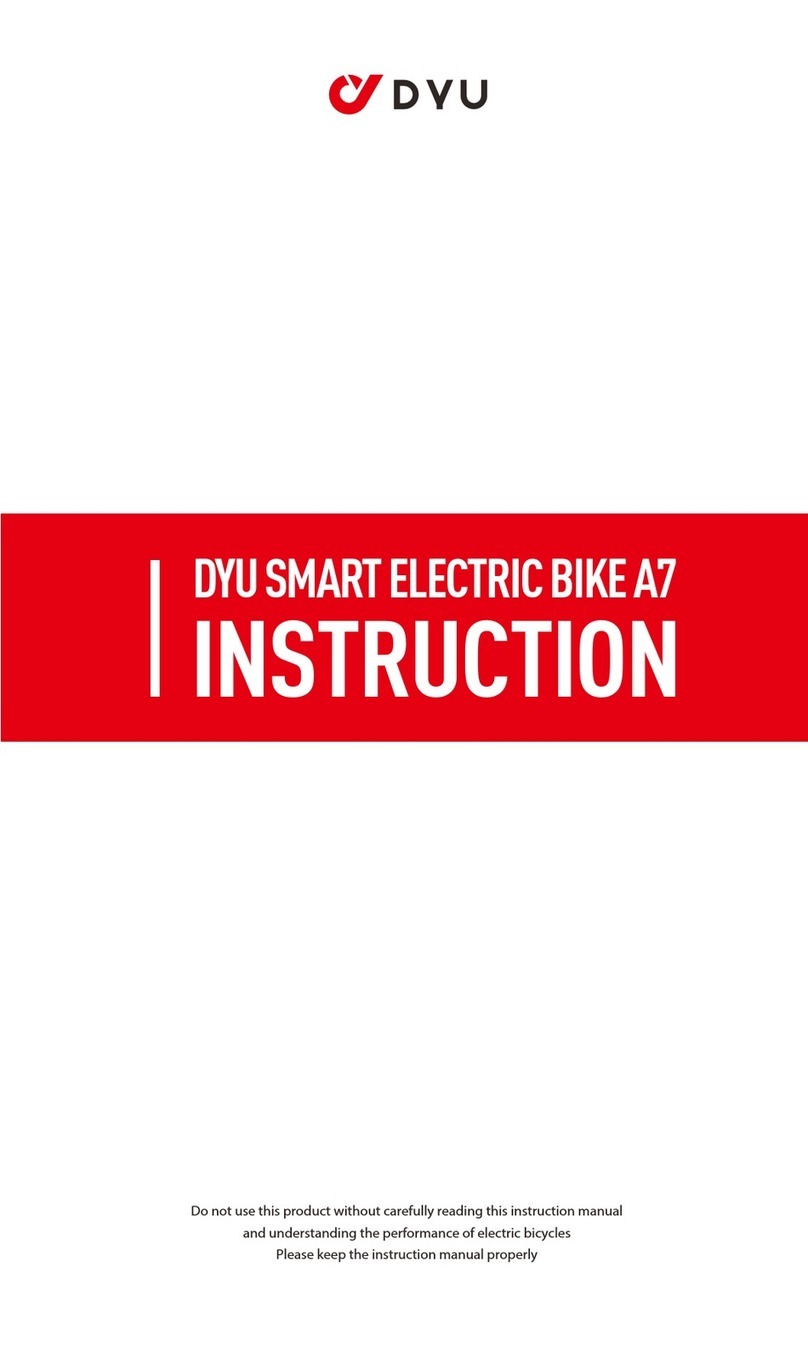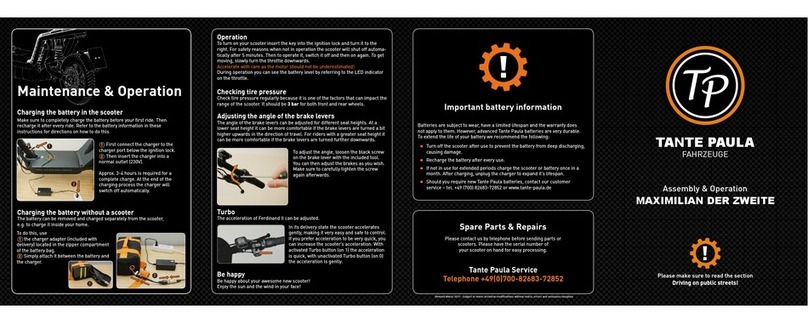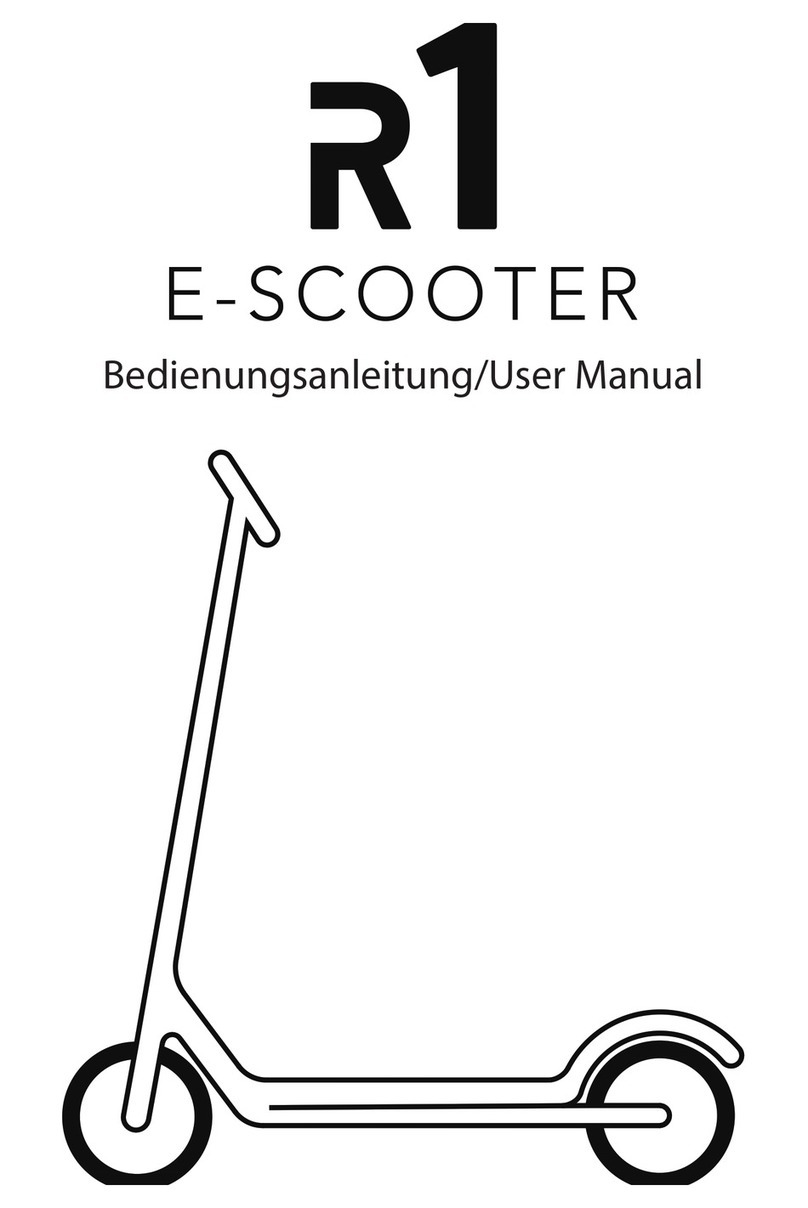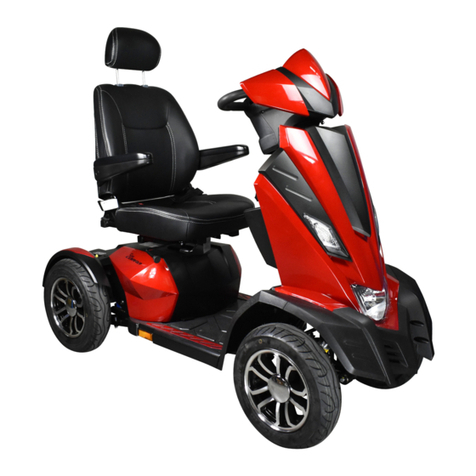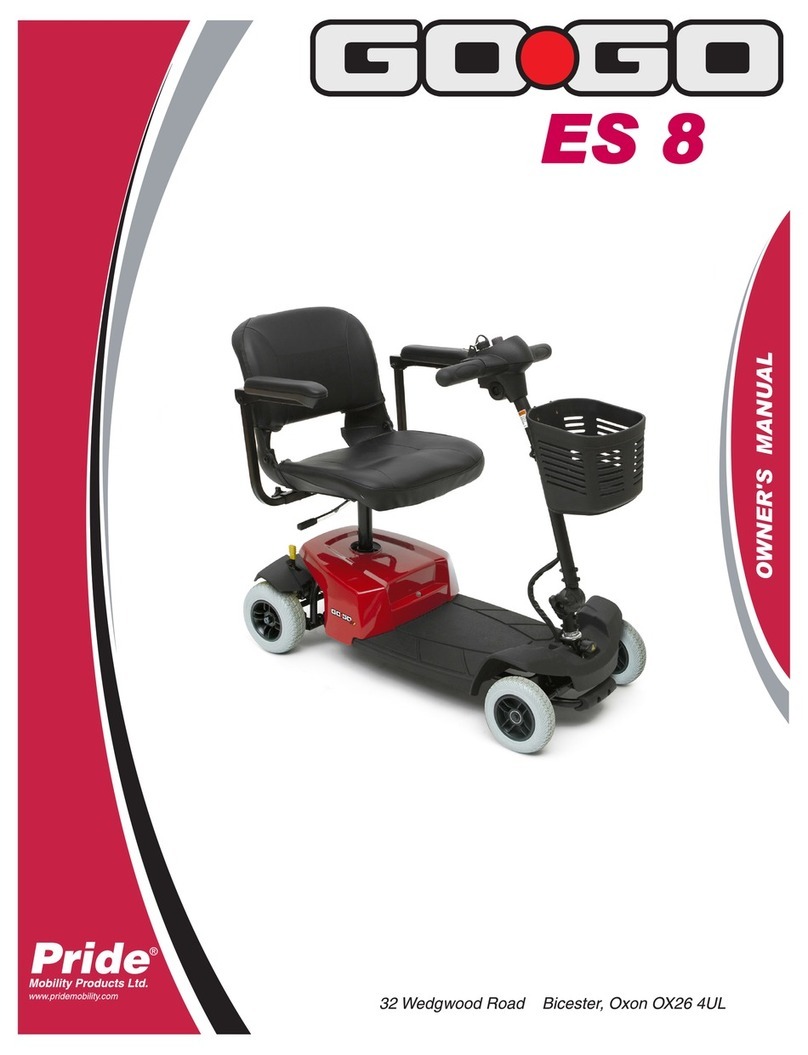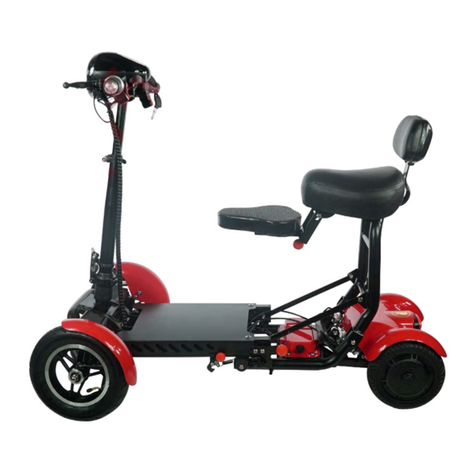Trikke Pon-e 48V User manual

Trikke EV - Pon-e Owner’s Manual v5 06/30/14
Dual Independent
Rear Disc Brakes
High Pressure
Air Tires
on Alloy Rims
T8air Deluxe Carving
Vehicle with Foldable
Aluminum Frame
trikke.co m
Owner’s Manual
Brake Levers with
Parking Lock
Feature
Twist Grip Throttle
with Charge Level
Indicator LEDs
Adjustable Handlebar Height
with Quick Release
Powerful 10’’
Hub Motor in
Front Wheel
(180W, 250W
or 350W)
Patented
High Performance
3CV Cambering System
Dual Speed
Econo & Turbo
Panasonic Lithium Battery
Pack with On-off Key
THIS MANUAL IS FOR THE FOLLOWING MODELS:
Pon-e 48V
Pon-e L 36V
ELECTRIC VEHICLES

Trikke EV Owner’s Manual - V5 06/30/14 - page 1
Thank you for purchasing a Trikke ™ product.
This manual is designed to help you get the
most out of your Trikke Electric Vehicle. The
warnings and instructions have been carefully
prepared to make your experience safer and
more enjoyable. Use common sense when
riding. Read an understand the Safety
Information section on page 15.
IT IS IMPORTANT TO READ THE
WARNINGS, SAFETY INFORMATION
AND RIDING TIPS

Trikke EV Owner’s Manual - V5 06/30/14 - page 2
ŸAlways use proper safety equipment when riding the Trikke EV including a helmet
approved by ANSI, Snell, CPSC, ASTM or DIN EN1078. Use proper footwear and make
sure that shoes with laces are properly tied before riding.
ŸAvoid water, bumps, gravel, sand, cracks, uneven surfaces or obstacles that may
suddenly block your way or cause you to lose control. The Trikke EV is not intended for off
road use. Avoid using at night.
ŸRiding with only one hand or no hands can be extremely dangerous. Use both hands to
hold the handlebars firmly at all times. Do not push too hard or apply uneven pressure to
the two different sides of the handlebars. Do not make sudden sharp turns or apply
your body weight on the handlebars when turning. Such actions can make the front
wheel of the vehicle quickly turn to one side and causing the vehicle to “jack-knife” or
stop suddenly, which can cause fall and serious injury to the rider.
ŸTricks, riding or rolling backwards and/or extreme riding are not recommended on the
Trikke EV. Riding this way you can damage the product, voiding your warranty and may
result in injury or death.
ŸDo not pull up on the handlebars because in doing so the rider can slip off the foot
platforms, resulting in serious injury or death. The rider must keep his weight within the
area delineated by the three wheels and step on the center or frontal part of the deck,
never on the back.
ŸRiding down hills is not recommended, especially for novice riders. The Trikke EV is
designed primarily for use on flat, dry asphalt. Extreme caution should be used when
riding on any inclined surface.
ŸWe recommend that you do not exceed the Trikke EV maximum rider's weigh limit of
250 lbs (113kg).
ŸA rider should be constantly on the lookout for obstacles, debris, cracks or holes in the
riding path, allowing them to be anticipated and avoided.
READ AND UNDERSTAND the sections of assembly, maintenance
and safety in the owner's manual before riding. Always follow the
directions and read all warnings.

Trikke EV Owner’s Manual - V5 06/30/14 - page 3
ŸBecause of the speed increase, the risk of injury and death are increased when riding
with the electric motor. Attention to the ride is a constant.
ŸThe braking to a full stop, at high speed, in a safe environment, to assess the distance
required to stop.
ŸBe aware of low objects. You are taller than you think when you ride the Trikke EV. Be
ready to duck for tree branches, street signs, etc..
ŸWhenever you ride, follow the traffic rules, including traffic signs, traffic lights and
crosswalks. Usually, you must follow the same rules as a bicycle or an electric bicycle.
ŸTire wear, puncture, or blowout may result in sudden loss of control, which can cause
serious injury. Always make sure that the tire maintenance is being done correctly.
ŸBraking and locking or skidding with the rear wheels will damage the tires, and such
damage is not covered under warranty. Rider may lose control and fall when locking the
wheels during braking. Control braking power by the force applied on the brake lever.
ŸIf you do not have the proper tools or find that you are unable to understand the
assembly instructions, contact an authorized dealer to assemble the Trikke EV for you.
ŸStop riding immediately if you suspect that some part of the vehicle is not working
properly. Inspect the vehicle to confirm what the problem is. Contact your dealer or
TRIKKE Technical Support directly if you suspect that a there is a malfunction or defect
that affects safe operation.
ŸIf you do not understand how to operate the Trikke EV properly, do not use it. Contact
your dealer or Technical Support Trikke for proper training.
ŸAlways inspect your vehicle before each use and make sure the handlebar clamp and
folding mechanism of the arms are locked in place. Read the important assembly,
operation and maintenance information in this manual.
ŸTest the brakes properly before each use; always engage both brakes equally with your
weight evenly distributed over the rear wheels.

Trikke EV Owner’s Manual - V5 06/30/14 - page 4
ŸChildren must be supervised by an adult while riding. The parent is responsible for
proper maintenance and vehicle inspection before each use. The Trikke EV is not
recommended for children under 13 years of age or less than 5 feet tall.
ŸAlways use caution when you are riding close to other vehicles, pedestrians, and
especially near cars if you're riding on a street. Obey all traffic laws. Be courteous to
drivers of other vehicles and pedestrians. Share the road!
ŸDo not modify your Trikke EV. Use only original Trikke parts or accessories. See limited
warranty for restrictions on use of non-original parts or modifications.
ŸAny modification of the electrical system will void the warranty, to increase the speed
or power of the motor.
ŸThe electrical system is designed to operate at 36 volts or 48 volts, according to the
model. Using any other batteries than the original TRIKKE lithium-ion battery and
charger can result in system failure. Any modification will void the warranty. Trikke Tech;
Inc. is not liable for injuries and / or death or any other damages caused by such changes.
ŸThe Trikke EV vehicle is a lightweight, low-power electric vehicle, and may require the
rider's help. Continuous turning right and left should be applied to help the engine while
on a climb.
ŸThe use of the electric motor will propel you to speeds you may not be accustomed
to, and may be beyond your skill level. Begin by practicing at lower speeds for your
own safety.

ŸThe Trikke EV is an electric vehicle and as such there is potential for shock or fire, if the
electrical system is tampered with or exposed to conditions of high humidity, causing
possible short circuit or overload of the electric system. Electrical components must be
protected from conditions of high humidity and physical damage.
ŸUsing a charger other than the original Trikke charger can cause overheating of the
battery and potential risk of fire.
ŸCOMMON SENSE AND EDUCATION ARE VERY IMPORTANT IN THE OPERATION OF
YOUR TRIKKE EV. DRIVERS SHOULD USE COURTESY WHEN USING AND SHARING THE
ROADS AND SIDEWALKS. PEDESTRIANS ALWAYS HAVE THE RIGHT OF WAY. WHEN
RIDING ON PUBLIC ROADWAYS, KEEP ON THE RIGHT SIDE OF THE ROAD AND REDUCE
YOUR CARVING ACTION TO MINIMIZE CAUSING CONFUSION WITH THE OTHER
DRIVERS ON THE SAME ROUTE.
ŸREMINDER: TRIKKE VEHICLES ARE DESIGNED TO RIDE FORWARD ONLY. PLEASE, DO
NOT RIDE BACKWARDS AS THERE IS THE POSSIBILITY OF DAMAGING THE FRAME.
Trikke EV Owner’s Manual - V5 06/30/14 - page 5

Know the
Trikke EV
* - POWER COMPONENTS
Handlebar
Handgrip
Brake Lever
Stem
Handlebar Height
Adjustment Quick Release
Decks
Right Arm
Left Arm
Rear Wheel
Front Fork
Front Wheel / Motor Assembly*
Fairing
Skirt
Brake Caliper
Front
Tube
Cambering
Axle
Steering
Stopper
Steering
Axle
Folding
Mechanism
Cambering
Joint
Battery*
Speed Switch
1-2*
Controller Box*
Speed
Throttle*
Trikke EV Owner’s Manual - V5 06/30/14 - page 6

Your Trikke EV is
pre-assembled
and requires only
the mounting of
the handlebar
and a quick check
of some items
before riding.
Trikke EV Owner’s Manual - V5 06/30/14 - page 7
Trikke EV - First Assembly
Step 1: Unfold the Frame
Please see page 10 for how to fold and unfold the frame.

The vehicle must be positioned in its standing position to mount the handlebars.
We recommend that you lock the parking brakes before putting on the handlebars to keep
the vehicle stationary during installation.
Position the handlebar with brake cables ahead. See pictures below for reference.
Note: The throttle cable is attached to the right brake cable.
Loosen the two screws on the handlebars stem with 4mm allen wrench provided. Slide the
handlebar stem (with handlebars pre-attached) onto the top of the steering post and
tighten the two screws. The top bracket should be flush with the top of the steering post.
Align the handlebars perpendicular to the front wheel (or parallel to the axis of the front
wheel). Once positioned, tighten the two screws evenly. The final torque should be given
after the alignment is correct.
Trikke EV Owner’s Manual - V5 06/30/14 - page 8
Step 2: Mounting the Handlebar
LOCK
LOCK
Step on the vehicle, in riding position,
hold it with both hands on the
handlebars and look down the front
tube. Adjust the handlebar by aligning
the axis of the front wheel with the
handlebars (you may need to loosen
the bracket screws to adjust the
alignment of the handlebars if they are
tight).
Aligning Handlebars

Trikke EV Owner’s Manual - V5 06/30/14 - page 9
To adjust the handlebar height, it is necessary to unlock the clamp. Note that there are holes
in the back of the steering shaft establishing a number of positions for height positioning.
There is a locking pin that fits these holes to provide a second level of security while driving.
Push the locking pin to release the steering post and slide (up and / or down) to the desired
height. Once positioned, close latch clamp, making sure it is securely locked.
If the clip is a little loose, tighten the adjusting nut manually. Adjusted properly, it requires a
steady hand to clamp.
Adjusting Handlebar Height
After learning to ride, you can
adjust the position of the
handlebars (angle and height)
to better suit your riding
posture. You can also adjust
the angle of brake levers for
comfort of use (but do not
position too far back to avoid
interference when folding the
arms of your Trikke EV).
Installing the Battery
ŸMake sure the battery key is set to unlocked position before installing.
ŸFor 36V with fairing only: remove the key before installing and insert the key through the
faring hole after.
ŸSlide the battery down on the rail until it sits on the tray. Do not force the battery in an
angle - make sure it will slide straight on the rail.
ŸTurn the key clockwise to locked position while pushing the battery down (the battery is
pre adjusted for a tight fit).
ŸTurn the key to the next position clockwise, to turn the battery ON.

Trikke EV Owner’s Manual - V3 11/10/10 - page 10
11
2
2
UNLOCK
LOCK
Unfolding the Frame
In front of each arm there is a folding mechanism with a knob that
must be pulled and twisted to keep the lock open to allow the
folding process. Position the vehicle so that it is standing on its
rear wheels to access and operate the folding levers. Once
unlocked, put the vehicle on the ground and lift the front column.
Twist the knobs back to release the folding mechanism, allowing
ŸTurn the key counterclockwise to OFF position. Push the key in and turn
counterclockwise again to unlock the battery (for 36V with fairing only: remove the key
before pulling up the battery). Pull the battery up by the handle the entire extension of
the rail until it’s free.
ŸBe careful to not drop the battery on the ground during installation and removal.
ŸBattery can remain either installed to the Tribred or removed for charging.
Removing the Battery
them to lock in place (frame mounted). You should hear two clicks indicating the locking of
each arm.
Folding the
Frame
UNLOCK
LOCK

Trikke EV Owner’s Manual - V5 06/30/14 - page 11
Brakes
BRAKE
CABLE
BRAKE
CALIPER
BRAKE
ROTOR
The disc brakes come preset from the
factory. We recommend that you check the
brakes before the first use (and before every
ride), squeezing the brake levers repeatedly
to feel the tension in the brake cable. Then
check if the rear wheels spin freely, or if
there is some noise when the brake is not
being applied. Also make sure that the
brakes work enough to stop the moving
vehicle and parking brakes hold up well
when locked.
The images to your right shows a disc brake installed and
adjusted correctly. There should be a gap on both sides
of the brake disc to the inside and outside brake pads.
Position yourself between the two arms of the Trikke EV holding the handlebar stem with
one hand. With the other hand, pull back the folding knobs on both sides into the
unlocked position. Start folding the frame and then release the levers from the unlocked
position. Fold the frame fully by pulling the handlebar back and down towards the
platforms until the folding mechanism locks into folded position - you'll hear a click for
each side locking individually.
Adjusting the Brake Pads
OUTSIDE
3mm
ALLEN WRENCH INSIDE
ADJUST 5mm
ALLEN WRENCH
LOCK /
UNLOCK
2.5mm
ALLEN
WRENCH
CALIPER
BRAKE ROTOR
BRAKE PADS

Trikke EV Owner’s Manual - V5 06/30/14 - page 12
Loosen the set screw of the
inner drum (step 2a, use 2.5
mm allen wrench) to unlock
the movement of the inner
brake pad. Move the inner
pad in or out against the
disc as required (step 2b,
use 5 mm allen wrench).
3
Move the outer brake pad in or out as necessary (step 3,
use 3 mm allen wrench) - note that the adjustment screw
is inside the hole at the bottom - do not loosen the 5mm
4a 4b
Adjust the inner pad (this pad is fixed and doesn’t move when applying brake):
Outer pad adjustment
(this pad moves towards the disc when applying brake)
Spin each wheel. If there is a visible warping on the rotor, mark where the rotor is off and use
your fingers to bend the rotor in or out to straighten it. Repeat this procedure until the disk
rotates without oscillations. (This is a common procedure, because the discs are thin and
can deform easily. With use, and consequent increase in temperature, the disc tends to
straighten itself).
Rotor Warping
2a 2b
After adjustment, the set screw of the drum must be tightened to lock and prevent vibration.

Trikke EV Owner’s Manual - V5 06/30/14 - page 13
Tires
The front and rear tires of the Trikke EV come with lower pressure from the factory, for
transport reasons. You will have to adjust tire pressure according to the weight of the
rider and usage preferences. Do not exceed the recommended tire pressure.
Example of recommended pressure:
Tire pressure affects energy consumption and battery range. Lower pressure makes a
smooth ride, but will require more energy due to increased rolling resistance. Higher
pressure reduces rolling resistance and increases mileage, but it makes a bumpier ride. Do
not run with very low pressure, as this can damage the tires, negatively affect braking
efficiency and increase the risk of a fall.
Particularly the front wheel (motor wheel) should not be calibrated with a pressure higher
than recommended, as this can damage the engine due to the reduction in impact
cushioning.
After some time of use, the brake pads will wear out and the brake will need to be adjusted
tighter in order to work efficiently. Readjust the brake by moving the outer pad (use 3mm
allen whench, picture 3) and, if needed, by moving the inner pad (use 5mm allen whench,
picture 2). DO NOT TRY TO ADJUST THE BRAKE CABLE, AS IT WILL NOT BE NEEDED, ADJUST
ONLY THE BRAKE PADS.
TIRE TYPE
RIDER’S WEIGHT
HD TIRE - FRONT
HD TIRE - REAR
FITNESS TIRE - FRONT
170 lbs (75kg) 250 lbs (113kg)
40 psi (2.8 bar) 50 psi (3.5 bar)
50 psi (3.5 bar) 60 psi (4.1 bar)
70 psi (4.8 bar) 80 psi (5.5 bar)
FITNESS TIRE - REAR 90 psi (6.1 bar)80 psi (5.5 bar)
WE RECOMMEND TO CHECK AND PUMP THE TIRES TO OPTIMAL PRESSURE EVERY
15 DAYS, USING A MANUAL OR SMALL ELECTRIC PUMP.
MAKE SURE TO USE A PUMP WITH ACCURATE PRESSURE GAUGE.
WARNING!
Do not use automated calibrator designed for large car
tires. It may overinflate the tire in the process and cause the
rupture of the tire or rim, with dangerous consequences.
psi
(bar)

Trikke EV Owner’s Manual - - page 14V5 06/30/14
WARNING!
Before riding the first time, please take a few minutes and
review the Safety Riding Tips on pages 3-6 of this manual.
For the safety of friends and others who will try your new Trikke
EV it is your responsibility to guide them how to ride safely.
Make sure you have read and understood all warnings and safety
information contained in this owner's manual before riding.
Please wear a safety helmet for riding.
ŸWhen you complete the assembly process, check the vehicle again and compare it to the
photograph on page 7.
ŸCheck the bolts that secure the front fork and handlebars. Push forward and pull back on
the handlebars strongly; this should immediately indicate if it is securely fixed or not.
ŸMake a final check of the brake by turning the rear wheels. They should spin freely until
you apply the brakes. It must be possible to vigorously squeeze the brake levers without
the brake levers touching the handlebars.
ŸCheck the folding mechanism to ensure that the arms are locked in the riding position.
Use as reference the lever lock / unlock sticker on top of the folding mechanism.
Pre-ride Check

Trikke EV Owner’s Manual - V5 06/30/14 - page 15
FIVE WARNINGS WERE SELECTED FROM THE LIST AT THE BEGINNING OF THIS MANUAL
FOR A MORE DETAILED DESCRIPTION. PLEASE READ AND UNDERSTAND THESE AND ALL
WARNINGS BEFORE YOU RIDE.
Avoid riding on wet or slippery surfaces (also surfaces covered by sand, gravel or mud)
because the wheels may skid and braking distance can be affected causing loss of control
and a possible crash. If necessary travel on slippery surface, try to travel in a straight line and
avoid leaning the vehicle to maximize stability and control.
Safety Warning 1: RIDING ON A WET OR SLIPPERY SURFACE
Safety Issues
Safety Warning 2: WEIGHT DISTRIBUTION
BrakingStarting
When accelerating, it is important to
place the weight on the front wheel, as
shown in the picture, keeping most of
your weight on your toes, feet
positioned in front of the platform. This
will ensure good traction of the front
tire.
Once you and your Trikke EV are in
motion, return to your normal posture.
Be careful not to lean too far back or
shift your weight behind the rear
wheels. This warning is especially
important for drivers who do not have good coordination, or are slow to react to an
unexpected event.
To brake more effectively, shift your weight back over your heels, over the rear wheels, as
shown in the picture, but be careful not to lean too far back. Apply both brakes
simultaneously (Trikke EV has independent brakes on rear wheels left and right
respectively actuated by levers on the handlebars left and right). Distributing your weight
evenly over each rear wheel is crucial for maximum braking efficiency. If you take the
weight off of the platforms during braking you will cause the wheel to lose contact with the
ground and lock.
The best way to ensure you are always well positioned and to minimize the risk of the
vehicle pull a wheelie, is to distribute your weight evenly between the front and rear
wheels, keeping your weight on your toes and putting your feet up to the front of the

Trikke EV Owner’s Manual - V5 06/30/14 - page 16
Proper use of the handlebars, and especially how to push it to the left and right is vital for
your safety. Because the front wheel is designed to trail the fork, the handlebar tends to turn
in the direction you tilt the vehicle. Unlike a bicycle, which tends to follow a straight line, the
front wheel will actually accentuate the turn. Because of this condition, less experienced
riders should pay special attention while driving. Turning the handlebars too far, and
allowing the front wheel to move quickly to the side, may cause the vehicle to stop suddenly
(“jack-knifing”), throwing the rider from the vehicle, which may cause injury. Always
maintain firm control over the handlebars with both hands, never drive with just one hand
or no hands. The Trikke EV requires both hands on the handlebars at all times.
Beginner riders have a tendency to apply excessive force on the handlebars, making sudden
movements, throwing their weight from one side to another. What propels the Trikke
forward manually is the leaning of the vehicle, a combination of turning and leaning of the
steering column, and not just pushing the handlebars from side to side. It is better to think in
terms of more leaning and less turning. Motion and trajectory in large ''S'' turns are best for
beginners.
Safety Warning 3: BEHAVIOR OF THE RIDER
Safety Warning 4: DOWNHILL
As the Trikke EV is a totally new machine, with a unique handling, we recommend that you
take time to familiarize yourself with the vehicle and to gradually explore the limits of
performance with each ride.
This is especially important before attempting climbs or steep descents. Riding uphill and
downhill are advanced and require you to be fully competent before even trying. On
descents, we strongly recommend that you only go down slopes on which you can
Avoid leaning too far over the handlebars - the rider must maintain balance on their feet, not
leaning on the handlebars. The legs should be slightly bent to absorb impact, balance the
body and ensure constant contact with the platforms.
Avoid leaning your body back, supporting yourself on your heels, stepping behind the center
of the rear wheels and pulling the handlebars back, because this way you will inevitably
reduce the weight of the front wheel losing traction and control, and you may fall back and
have an accident.
Another reason for a balanced weight distribution is to ensure a better use of traction (front
and rear tires) with no spinning or skidding during acceleration and braking.

Trikke EV Owner’s Manual - V5 06/30/14 - page 17
Safety Warning 5: SAFETY EQUIPMENT
ALWAYS USE SAFETY EQUIPMENT, ESPECIALLY A HELMET. A helmet is essential when
riding a Trikke EV or any exposed wheeled vehicle. We also recommend that you wear
gloves, elbow and knee pads, especially children and inexperienced riders. Although it is
a stable platform, there are always conditions that vary with the environment, which may
surprise you, such as cracks in the pavement, sand, gravel, potholes, tree branches,
people or other vehicles. Falls and accidents can occur.
Driving at night should be avoided, but in case of night time use we recommend the use
of headlamps and signal lights on front and rear. See and be seen.
Also the use of horn or bell helps you call attention and be noticed.
READ AND UNDERSTAND THE SECTIONS OF ASSEMBLY, MAINTENANCE AND SAFETY
MANUAL BEFORE RIDING. ALWAYS FOLLOW THE INSTRUCTIONS AND READ ALL
WARNINGS.
Visit our website at www.trikke.com if you want to buy safety gear (helmet, gloves, knee
and/or elbow pads).
control the speed by turning. Riding on hills at speeds that require constant braking are
not recommended for three reasons: you can reach speeds where the braking distances
needed are too long to stop you safely, and you may fall at high speed causing serious
injury or death, and you will simply wear out the brake pads and rear tires long before
their expected life expectancy.
The Trikke EV will accelerate quickly, so try to ride at speeds appropriate to your skill

Trikke EV Owner’s Manual - V5 06/30/14 - page 18
Riding Range
1. The possible distance per ride (mileage) of Trikke EV depends on many things, including
the topography of the terrain, the rider's weight, direction and speed of the wind,
temperature, throttle usage, speed setting (1 or 2), assistance with body propulsion, tire
type and pressure.
2. To extend the riding range of the Trikke EV, use Econo speed (1) 20 km/h max, avoid long
or steep climbing, help the vehicle as much as possible with body propulsion and use the
throttle sparingly, and keep tires inflated to the recommended pressure.
Vehicle Operation
1. To turn power ON, turn the battery key to "ON"
position. The battery charge lights on the throttle
should turn on, indicating that the vehicle is ready
for use. These lights show the estimate level of
battery charge. The lights will fade as the battery
charge decreases. There is also a state of charge
(SOC) indicator on the battery cover. Press the
button and the lights will show for 2 seconds
indicating 25-50-75-100% of charge level.
2. There is a speed limiter switch (arrow) on the
cover of the controller box. When set to "1" (Econo)
speed will be limited to 12mph (20 km/h). When
switched to "2" (Express), release the maximum
engine speed that is 16mph (25km/h). The Trikke EV
can travel faster on descents because it has a
Battery Life
Indicators
Twist Speed
Throttle
Push
to Check
Rider's weight:
max 113kg (250lbs)
Climbing:
max 5 degrees
Downhill:
max 10 degrees
Speed:
max 40km/h (25mph)
Riding surface:
smooth and good traction asphalt or concrete (not for
uneven rough pavement,off-road, slippery surface);
Weather:
light rain; not for use under heavy rain.
o
Temperature:
0 to 40 C (32-104F)
Vehicle Operational Limits

Trikke EV Owner’s Manual - V5 06/30/14 - page 19
4. Avoid starting with the handlebar turned, since you can lose balance and fall. Start with
the front wheel aligned forward and then initiate the turn of the handlebars once already in
motion.
5. When crossing the street, you will need enough time for a slow acceleration. Be wise and
consider the time required for the crossing. You can always walk the vehicle or give a push to
the ground for a quicker start.
6. Riders should consider the need for a generous distance to reduce speed (or stop) when
riding at high speed. Avoid riding on wet or flooded surface. The Trikke EV can withstand a
small amount of moisture, however, is not recommended for continuous use in rain or wet.
In the case the vehicle gets wet, remove the battery and keep it in a dry and ventilated
environment to dry the components. Avoid using the Trikke EV with wet parts. If the front
wheel (motor) has been submerged, water will get in and remain inside the motor. You will
have to drain the motor by removing the drain plug and spinning the motor off the ground.
wheels. When moving, you can turn over the
throttle to increase speed and control. Avoid
burning of rubber (spinning the motor freely) at the
start to not leave marks on the floor and prevent
premature tire wear.
freewheel inside the motor. Beginners should use the speed control and limit their speed to
12mph (20 km/h) or less, until they feel safe to operate at higher speeds. Speeds for Pon-eL
model are: 1-econo 9mph (15km/h), 2-express 13mph (21km/h).
3. To run the motor just turn the throttle back, like on a motorcycle (using the thumb and
forefinger). The accelerator is sensitive and must be rotated to progressively increase the
torque and speed. Be careful at the start cranking the throttle slowly until the vehicle starts
to move. Lean your body forward and step in front of platforms forcing your weight onto
your toes. This ensures the necessary weight on the front wheel, which is the traction
wheel. Once in motion, distribute your weight evenly between the front and rear
This manual suits for next models
1
Table of contents
Other Trikke Scooter manuals
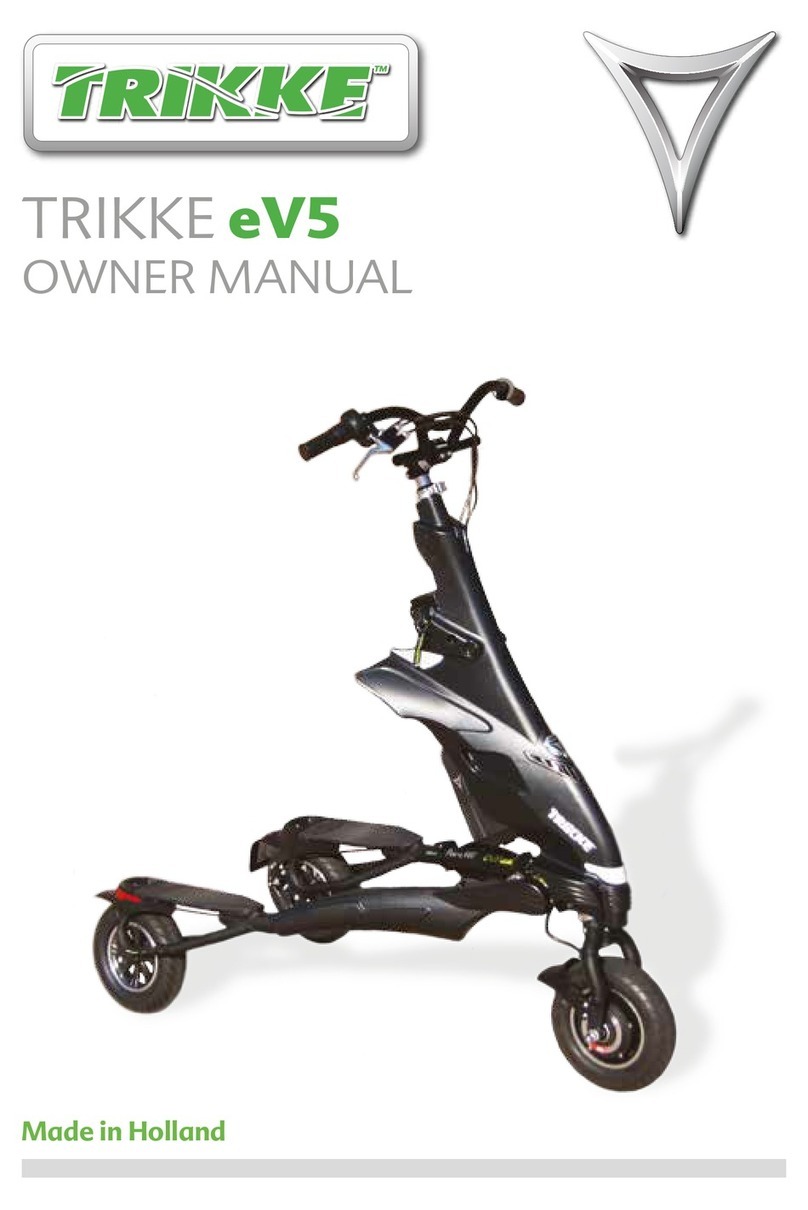
Trikke
Trikke eV5 User manual
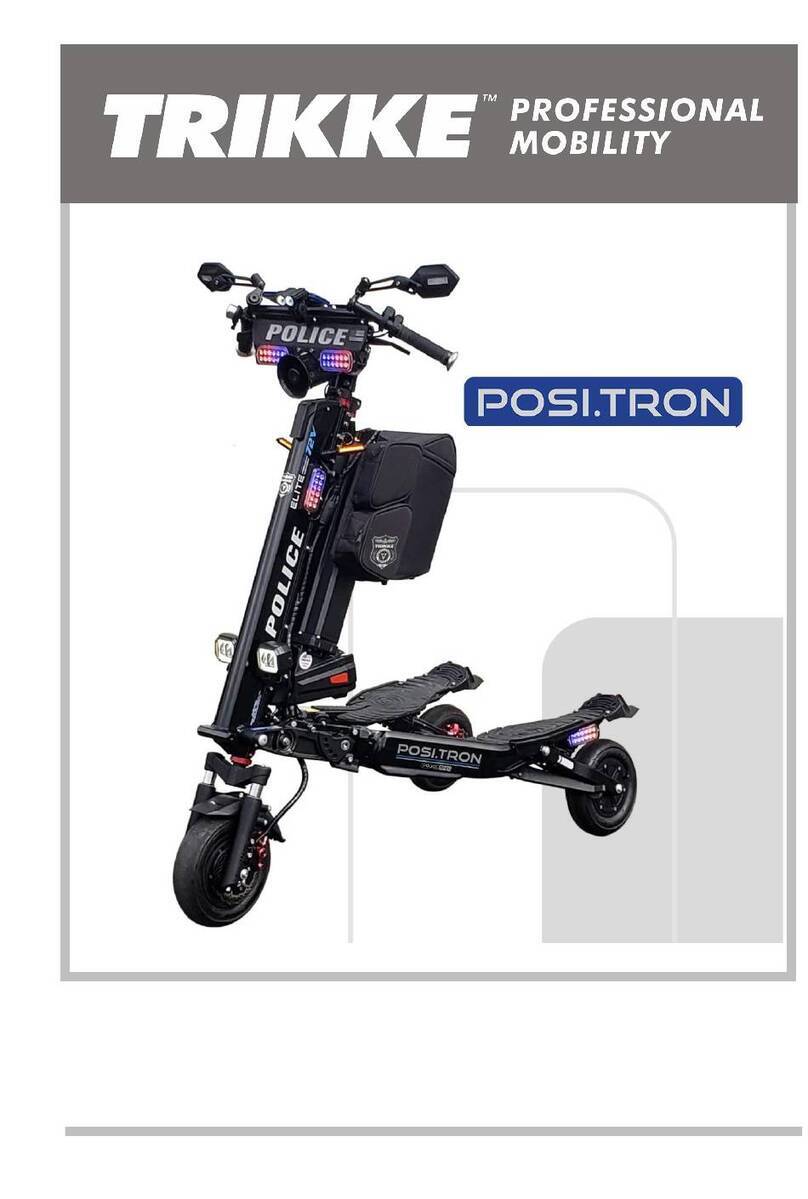
Trikke
Trikke POSITRON 60V AWD User manual

Trikke
Trikke uPT User manual
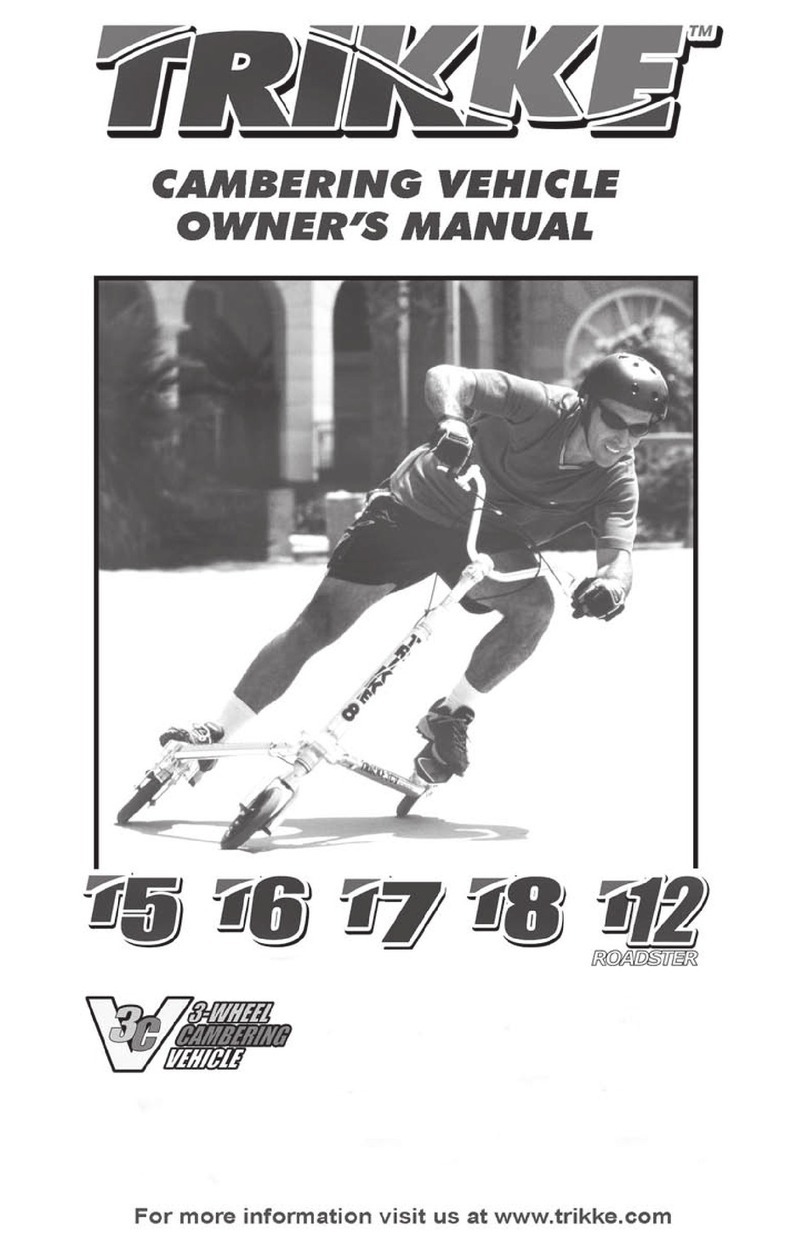
Trikke
Trikke T5 JOGO User manual
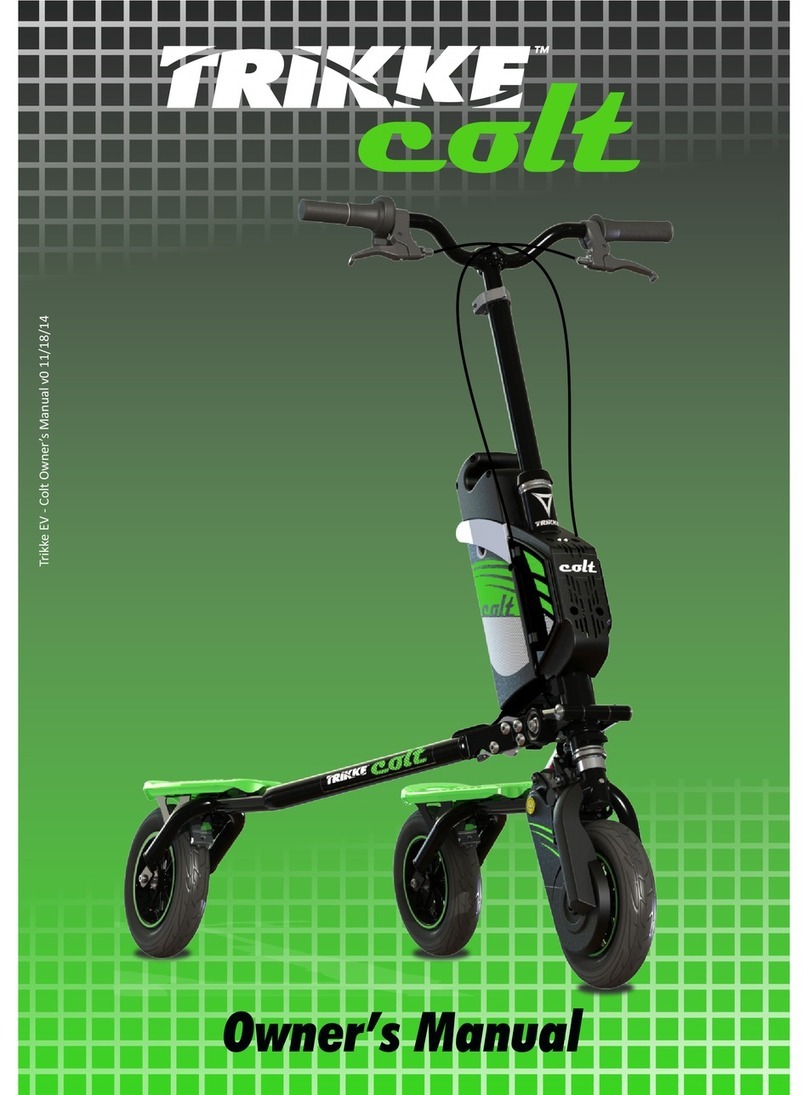
Trikke
Trikke Colt User manual
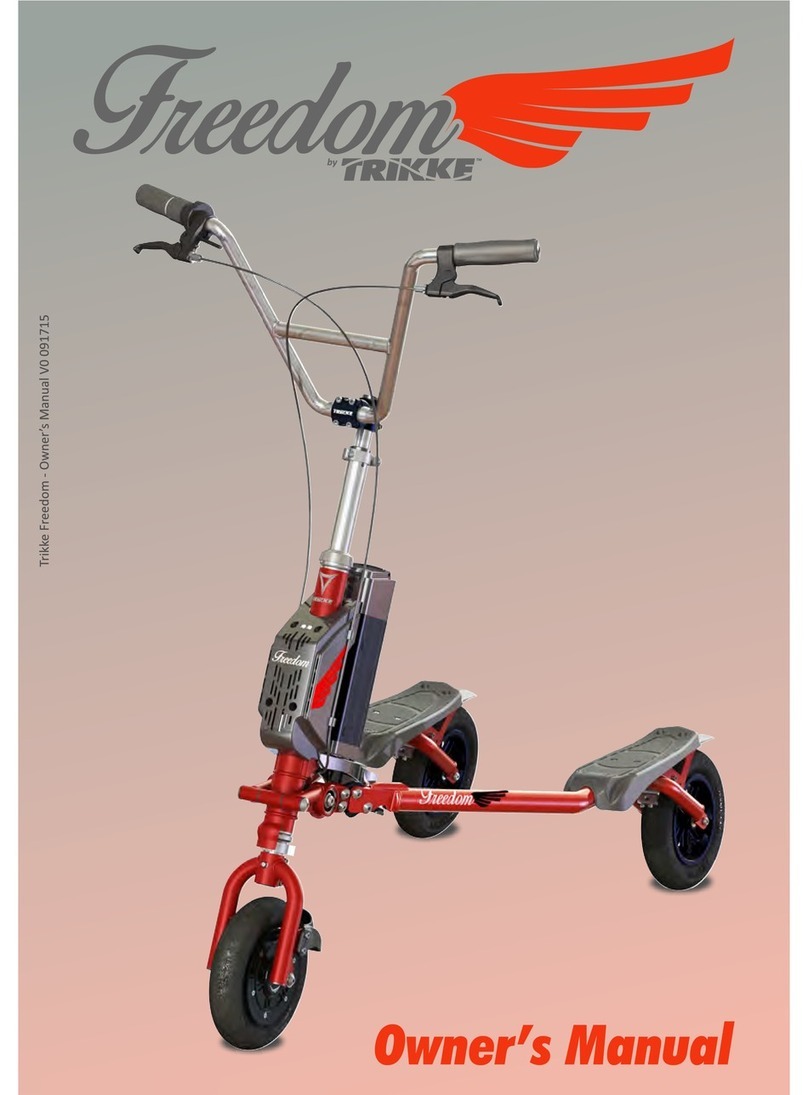
Trikke
Trikke FREEDOM User manual

Trikke
Trikke T7 User manual
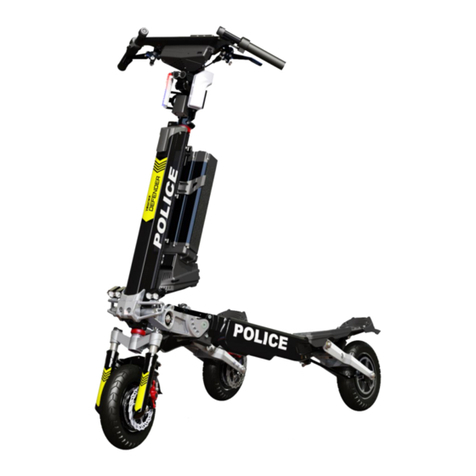
Trikke
Trikke DEFENDER User manual

Trikke
Trikke Tribred Pon-e User manual
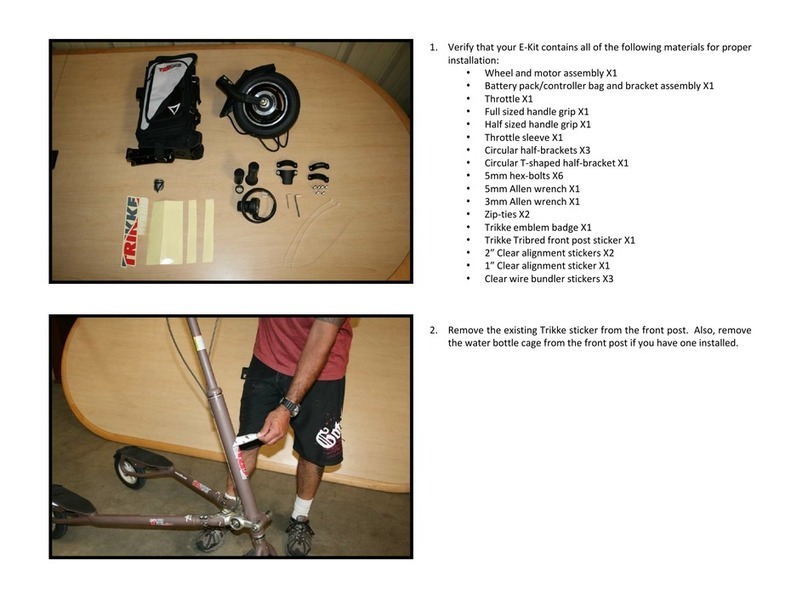
Trikke
Trikke E-Kit User manual

